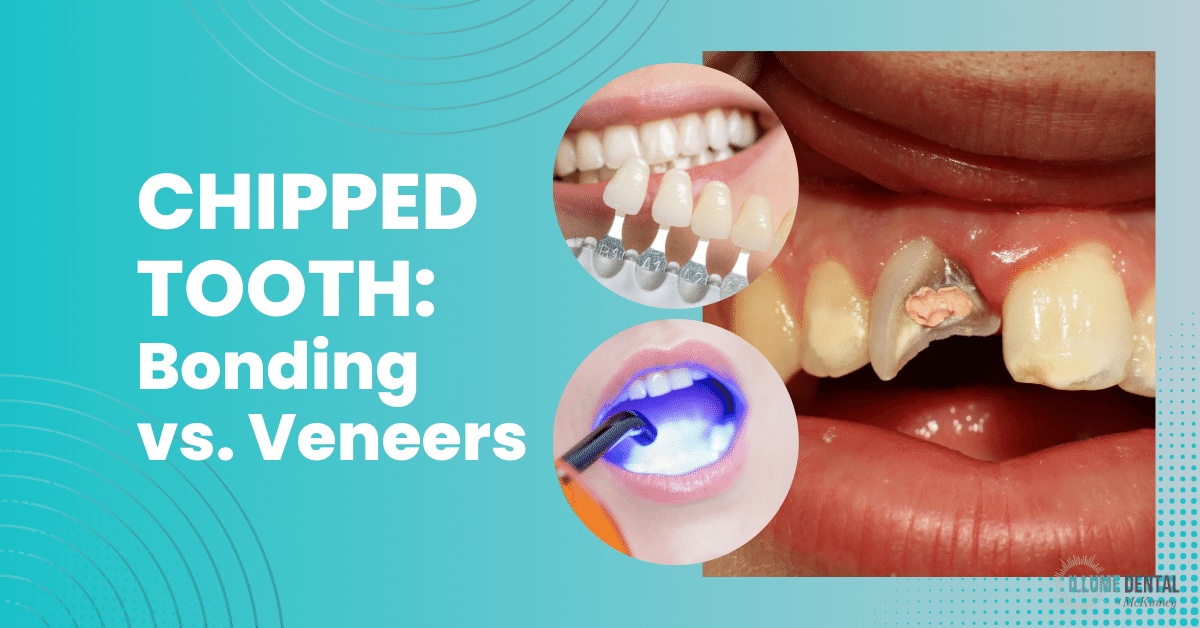Chipped Tooth: Bonding vs. Veneers

Two of the most common procedures when treating a chipped tooth are bonding and veneers. Both options offer unique benefits and can dramatically improve the appearance of your smile. Bonding chipped tooth is a cost-effective solution that includes filling the damaged region with a resin that matches the color of the tooth and then molding it to the desired shape. It’s a simple, painless procedure that typically requires just one visit.
Veneers, on the other hand, are shells that are manufactured to order and are bonded to the front of your teeth. We offer a more permanent solution than bonding and can correct several dental imperfections. However, getting veneers is more involved and may require several visits.
In choosing between bonding and veneers, it’s important to consider factors such as cost, time commitment, and your overall dental health. A consultation with a dental professional at Illume Dental of McKinney can help guide your decision and ensure you choose the best treatment for your needs.
At Illume Dental of McKinney, we understand that a chipped tooth can be uncomfortable and affect your smile’s appearance. Fortunately, modern dentistry offers effective solutions. Here’s a comprehensive comparison between bonding and veneers for repairing a chipped tooth:
What are the differences between bonding and veneers for repairing a chipped tooth?
Bonding
- Material: Bonding uses a tooth-colored resin composite material.
- Application: The resin is applied directly to the chipped area, shaped, and then hardened with a special light.
- Purpose: Bonding is suitable for minor to moderate chipping and is often used for small repairs.
- Aesthetics: While it offers a natural appearance, bonding may not be as translucent or long-lasting as veneers.
Veneers
- Material: Veneers are thin shells typically made of porcelain or composite resin.
- Application: Veneers require removing a small amount of enamel to accommodate the shells, which are custom-made and then bonded to the tooth’s surface.
- Purpose: Veneers are primarily used for more extensive chipping or when a more significant aesthetic transformation is desired.
- Aesthetics: Veneers provide a highly aesthetic, translucent, and durable solution that closely mimics natural teeth.
How do dental professionals determine whether bonding or veneers are the more suitable for a chipped tooth?
Dental professionals consider several factors when determining the most suitable option:
- Extent of Chipping: The severity of the chipped tooth is a crucial factor. Dental professionals assess how much of the tooth structure is compromised. Bonding is typically recommended for minor to moderate chipping, while veneers are preferred for more extensive damage.
- Aesthetic Goals: The patient’s desired outcome plays a significant role in decision-making. If the patient seeks a substantial improvement in appearance or has multiple cosmetic concerns, veneers are often recommended due to their versatility in creating a transformative effect.
- Tooth Health: The overall health of the chipped tooth is evaluated. A veneer may provide better structural support and protection if the tooth is significantly compromised beyond the chip, such as deep decay or structural issues.
- Patient Preferences: When making recommendations, dental professionals consider the patient’s input, budget, and long-term goals. Patient comfort and satisfaction are essential for a successful treatment outcome.
- Cosmetic Considerations: Factors such as the tooth’s position in the smile, its color, and the patient’s overall smile aesthetics are considered. Veneers can address multiple cosmetic concerns simultaneously, making them a versatile choice.
- Durability: Depending on the patient’s lifestyle and oral hygiene habits, durability is a critical factor. Veneers are superior to bonding in terms of durability and stain resistance, and they have the potential to endure longer if they are properly maintained.
- Cost: The cost difference between bonding and veneers is a significant consideration. Bonding is generally more cost-effective, making it an attractive option for patients with budget constraints.
Can bonding and veneers address more severe cases of chipped teeth, or are they primarily for minor repairs?
Bonding chipped tooth and veneers can address both minor and more severe cases of chipped teeth, but the choice is determined by the level of damage and the available options patient’s goals:
- Bonding is suitable for minor to moderate chipping, making it an excellent option for small repairs.
- It is often used to repair small chips or fractures in teeth and can be applied to specific areas of concern.
- Bonding is a versatile solution for minor cosmetic improvements and can restore the tooth’s appearance and function effectively.
- Veneers are primarily used for more extensive chipping or when a more significant aesthetic transformation is desired.
- They are thin shells that are built to order and cover the entire front surface of the tooth, making them ideal for addressing significant cosmetic concerns.
- Veneers can provide a comprehensive solution for chipped teeth, simultaneously improving their appearance, shape, and color.
- While bonding is suitable for minor to moderate chipping and can effectively repair small imperfections, veneers offer a broader scope of correction. They are often chosen when patients seek a more dramatic smile enhancement.Dental professionals will determine the severity of the condition chipping and the patient’s cosmetic goals to determine whether bonding or veneers are the most appropriate solution.
Are there factors such as cost, longevity, or aesthetics that patients should consider when choosing between bonding and veneers for a chipped tooth?
Patients should consider the following factors when deciding between bonding and veneers:
- Cost: Bonding is generally more cost-effective than veneers. However, veneers offer superior aesthetics and durability, which can justify the investment for some patients.
- Longevity: Veneers typically last longer than bonding. While bonding may need periodic touch-ups or replacements, veneers can endure for a decade or more with proper care.
- Aesthetics: Veneers provide superior aesthetics, resembling natural teeth in clarity and appearance. They are often chosen for their cosmetic benefits.
- Durability: Veneers are more durable and resistant to staining compared to bonding. They offer greater longevity and are less prone to discoloration.
Choosing between bonding and veneers depends on the patient’s priorities and budget. Consulting with a dentist is essential for making an informed decision.
What is the procedure for getting bonding or veneers to fix a chipped tooth, and what are the expected results in terms of appearance and durability?
Procedure for Bonding
- Consultation: The dentist assesses the chipped tooth and discusses treatment options with the patient.
- Preparation: Minimal tooth preparation is needed. The dentist roughens the tooth’s surface to ensure proper adhesion.
- Bonding: The tooth-colored resin is applied and shaped to match the natural tooth. A special light hardens the material.
- Finishing: The bonded area is polished to achieve a natural appearance.
Procedure for Veneers
- Consultation: The dentist evaluates the chipped tooth and discusses the desired outcome with the patient.
- Tooth Preparation: A small amount of enamel is removed from the tooth’s surface to accommodate the veneer.
- Impression: An impression of the tooth is taken to create a custom veneer.
- Temporary Veneer: A temporary veneer may be placed while the custom one is fabricated.
- Bonding: The custom veneer is permanently bonded to the tooth using dental adhesive.
Expected Results
- Bonding: Bonding provides a natural appearance but may require periodic touch-ups or replacements. It is less durable than veneers but can last several years with proper care.
- Veneers: Veneers offer superior aesthetics and durability. They closely mimic natural teeth in appearance and can last a decade or more with proper maintenance.
Both bonding and veneers can provide excellent results, restoring the appearance and function of a chipped tooth. The choice depends on the patient’s specific needs and preferences.
Restoring Your Smile with the Right Solution for Your Chipped Tooth
At Illume Dental of McKinney, we understand the importance of restoring your smile after a chipped tooth. Whether your chipping is minor or more extensive, we offer the right solution tailored to your needs. Our dental professionals expertly assess the damage and your cosmetic goals to determine if bonding or veneers are the ideal choice. With our guidance, you can confidently regain a beautiful and functional smile. Trust us to provide the perfect solution that enhances your confidence and oral health. Experience personalized care and comprehensive solutions for your chipped tooth at Illume Dental of McKinney.

